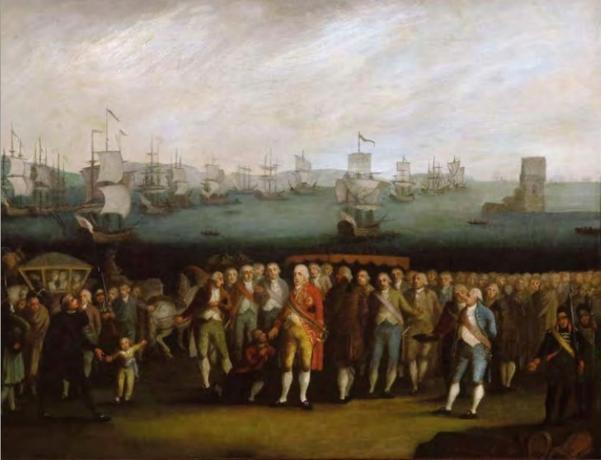THE Conquest of Ceuta occurred in 1415 and symbolizes the beginning of Portuguese overseas expansion.
The objective of the Crown, driven by the bourgeoisie, was to seize the city that received the Moorish caravans that transported gold, ivory, spices and slaves.
Portuguese Maritime Expansion
When King Dom João I (1351-1433) assumed the Portuguese throne in 1385, the kingdom faced financial difficulties. Portugal faced the lack of agricultural products, labor and its currency was devalued.
The insufficiency of precious metals influenced the enactment of a law, in 1402, which prohibited the export of gold, as without the metal, it was not possible to mint coins.
Therefore, the king began to look for alternatives to the economic crisis. One of the ideas was to expand the kingdom to the Mediterranean and not Europe.
Thus, influenced by his sons, he began to build a huge armada in order to conquer the square in Ceuta.

Causes
Several reasons were considered for choosing Ceuta. The conquest of the Emirate of Granada was even considered. The guarantee of support from the Crown of Castilla contributed to Ceuta being chosen. Furthermore:
- Ceuta was a rich locality next to the Strait of Gibraltar, a meeting point for caravans coming from the Orient and a way to reach the cereal markets of Morocco;
- It would be a way to help overcome the economic crisis
- By conquering Ceuta, all sectors of Portuguese society would be involved in the hope of benefits;
- It would enable the expansion of the Christian faith into Muslim territory.
Internal Policy
The Portuguese nation was at peace, and unified around a king, unlike most neighbors still at war. In any case, overseas conquests channeled the warrior spirit of the nobility and helped to maintain harmony within the borders.
Portugal had a geographical position that favored the search for alternative routes by sea for the purchase of goods.
The bourgeoisie saw commercial advantages due to the city's strategic position. The nobility, on the other hand, thought of increasing their possessions and titles; while the clergy imagined winning more souls. For the people, the belief was in more work.
Faced with so many advantages and needs, the process of conquering Ceuta began.
Expedition
The expedition left Lisbon on July 25, 1415. It consisted of a fleet of 212 vessels, of which 59 were galleys, 33 ships and 12 small vessels.
Were shipped:
- 7,500 knights
- 500 crossbowmen (those wielding the crossbow, a bow and arrow weapon)
- 21,000 foot soldiers
On August 22, 1415, they took the city and ransacked it during the night.
Immediately, the transformation of the city of Ceuta began. Muslim symbols were replaced by Christian symbols and the mosque was transformed into a church.
The Portuguese Crown left 2,700 men under the command of Dom Pedro de Meneses (1370-1437), the first governor of Ceuta.

Occupation
What the Crown and the bourgeoisie imagined, however, did not happen. Conquering Ceuta put even more pressure on the Portuguese coffers and it was necessary to take out loans to pay for the incursion and repay the Spanish support.
Above all, the city now needed to be maintained, protected and even fed, as its wheat production was insufficient.
In 1419, for example, the armies of the Sultanate of Morocco and the Emirate of Grenada tried to reconquer the city and lay siege to it for a month. Later, the caravans, which gave so much profit to the place, were diverted to other coastal cities.
Although there were so many unfavorable elements, the Portuguese decided to stay in Ceuta.
Even with all the problems, Portugal would continue to invest in navigation. The next step was to occupy the islands of Madeira, in 1419, and later, the Archipelago of the Azores, in 1427.
However, several nobles were indecisive with the overseas expansion policy due to the lack of resources and the low demographic density of Portugal.
The impasse lasted until 1433, when Infantes Dom Henrique and Dom Fernando (1402-1443), and more Count of Arraiolos, Dom Fernando de Portugal, insisted on proceeding with the maritime expeditions. In the meantime, King Dom João I dies and his son Dom Duarte ascends to the throne.
In this way, King Dom Duarte I (1391-1438) approved an incursion to take Tangier (Morocco) in October 1437.
In combat, Infante Dom Fernando was taken hostage by the Moroccans and his life was traded in exchange for handing over Ceuta.
The standoff creates tension in the court with supporters on both sides. Without an agreement, Dom Fernando died in captivity, Ceuta remained in possession of Portugal.
Curiosities
- Ceuta passed the hand of the Spaniards in 1668 after the end of the Unity Iberian and remains Spanish to this day.
- The Portuguese influence is felt in the architecture, in the coats of arms and in the devotion to Our Lady of Africa.
- At São Bento station, in the city of Porto, Portugal, there is a huge tile panel on the conquest of Ceuta. This is because most of the vessels used in the expedition came from shipyards in the region.
Read more:
- The First Great Navigations
- Portuguese Navigations
- precolonial Africa
- Discovery of Brazil


